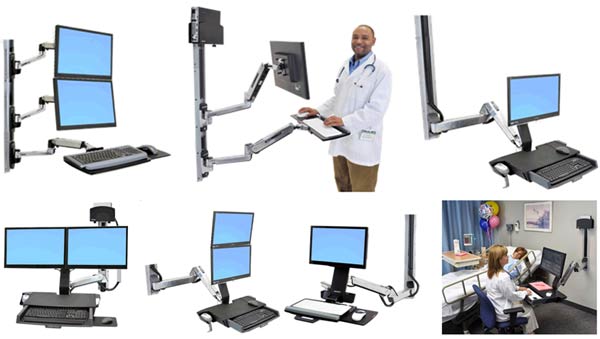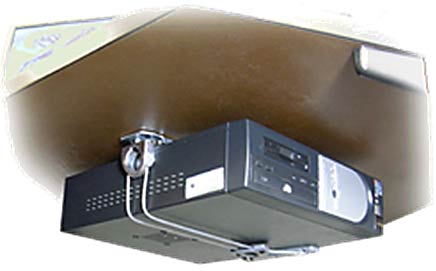Electronic Medical Records – Charting in the Patient Room

Should positively affect patient experience and infection control.
- Attractive “state-of-the art” appearance
- Streamlined for easy cleaning
- Maintains line-of-sight with patient
Should positively affect employee morale and productivity.
- Use while sitting or standing
- Provides maximum adjustability and ergonomics
- Maintains line-of-sight with patient
Should occupy a minimal amount of space
- Folds up and back, tight against wall.
- Occupies little or no more wall space than the monitor and keyboard alone
Consider multiple options for CPU mount
- Our largest customers use zero-client all-in-one computers with no separate CPU
- Consider large clamshell holders for full-size CPU’s
- Small clamshell holders for small form factor CPU’s
- Thin clients can be mounted between VESA mount and monitor
- Thin clients can also be mounted to slim quick-release mounts on track or wall

An excellent low-cost option is the secure cable mount below.
It can mount both horizontally and vertically.
Mount it under a worksurface, to a wall, or to an Ergotron track.

Charting in the Patient Room
EMR (HER) is best performed in the patient room. This keeps the doctor or nurse in company with the patient and assures information is entered promptly without interruption or memory lapses that might occur back at the nurses’ station.
This means a computer must be used in the patient room. Most medium to large hospitals have computers or host-connected devices permanently installed in each patient room. Thin-client or zero-client “all-in-one” monitors are the common choice in 2019.
The best device for holding the necessary monitor and keyboard is a double-articulating height-adjustable arm or arms holding the keyboard and monitor. While they may seem to be “a lot of hardware” or “too big for a small patient room”, the best ones fold back against the wall nearly as tightly as if they were flush-mounts and can be pushed upward or off to the side when not in use.
The most important reason for using a double articulating arm is to allow the user to maintain a line-of-sight with the patient. This is the number one priority in patient room charting. Patient satisfaction surveys tell us the patient should never see the doctor or nurse typing while their back is turned.
The best computer arms move up and down 20” or more for use sitting or standing and the keyboards fold up. An Ergotron 24-260-026 StyleView Sit Stand Combo Arm with Worksurface folds to just 8” from wall. Refer to our chart for evaluating arms.
Charting Gallery


